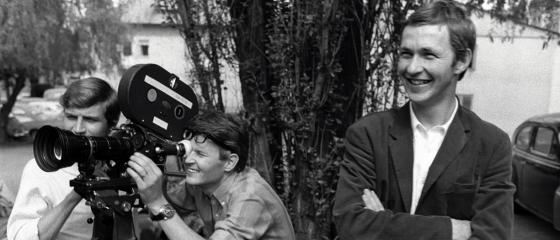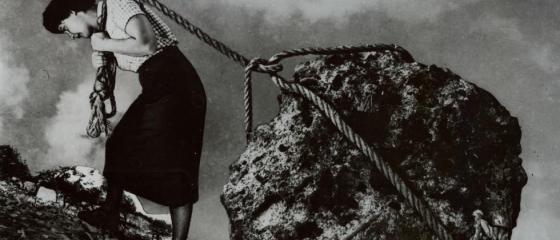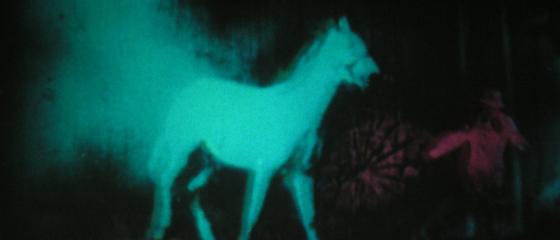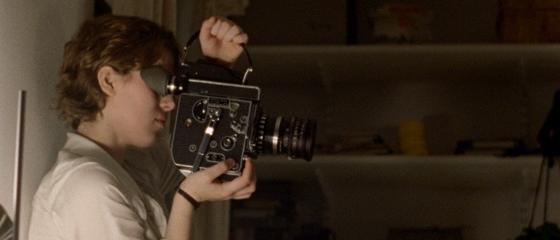A selection of interviews with Margarida Cordeiro and António Reis arranged by Manuel Asín, curator of the Seville European Film Festival 2018 retrospective dedicated to Portuguese filmmakers.

JAIME (1974)
The construction of the film is based on drawings, from which you go in and out. Meaning, the drawings aren't on one side and real life on the other. You go in and out freely. It's all part of a unit, the film. In the making there is a stylization of Jaime's representation, and in Jaime's representation, because of the stylization that was done, the hospitality ends up being reflected. [AR, JCM]
Throughout the initial sequence in sepia, the characters were directed, not in order to be aesthetically pleasing (although, for me, it was important to achieve this), rather as rigorously as a director expects of professional actors. Not so much for because of the exigency of raccords or rhythm, but because of the demand of asceticism that the roles have in the nobility of attitude, plastic aesthetic that Jaime also granted them. Thus I ended up perhaps creating a general atmosphere, between the plastic and reality, through that mutual interference. The more sculptural the figures are, the more human they are. [AR, JCM] As for the rest, if I had a concern it was of a moral nature: to uncover and destroy the border between normality and abnormality, without parti-pris, for the simple reason it is in my blood and in my intelligence, and because I am convinced that a large part of the freaks are out here and many of them even normal, hospitalized. In fact, I consider that division to be racist. It's one of the great problems of our time, anywhere in the world, and trying to destroy that prejudice was very important to me. We had, therefore, to think deeply about the privileged social place that the so-called mentally ill occupied in the communities studied by anthropologists. I worked with them with great joy. They were admirable in everything I asked of them and in everything they helped with. [AR, JCM]
Our agreement was to use handheld camera, representing the helplessness of the human eye. We felt that this was the best way to achieve a certain rawness of observation. Perspective struck us, the depth of field, or to do any kind of patterning or modelling. There is a kind of woodwork, in the shot, that narrows everything down to the essential. [AR, JCM]
Just as important as the dynamic connections of the film are the chromatic connectors which, at the same time, serve both for the continuity of the film and for the harmony of the aesthetic. These ties are both related and conflicting. Sometimes it seems as if the film is undone, but it is not. At such stages, other values are leveling off. [...] What fascinates me is to feel that the media provoke each other completely, without necessarily gaining autonomy. The film slipped away from us constantly. Jaime too would seem to run away. [AR, JCM]

BEHIND THE MOUNTAINS (1976)
No one can know in advance what kind of documentary this will be. It will involve a face-to-face struggle with ancient and modern forms, between wolves and a Peugeot 504, between Neolithic plows and gas cylinders. [AR, N]
A very important fact: they could verify by means of our work that we were also 'cinema peasants', because sometimes we worked sixteen, eighteen hours a day, and I think they liked to see us work. When we needed them to continue working with us, even leaving the animals without food or the children without care, they did not feel it, I believe, as an obligation. It was admirable. [AR, SD/JPO]
However, when the mother tells Blancaflor's story, are we looking at fiction or documentary? We're actually in both. Even in a village, an event can be fiction. The surprising thing about villages is that, when you're there, you see the golden air, the animals in the fountain..., but if you can go from one house to another, then to a river, then to a door, there things become so complicated that you can't just talk about fiction and documentary anymore. Precisely in that house, you can listen to the mother tell Blancaflor's story while she is working. The children of the Middle Ages are like Blancaflor in images. The thing you understand in these Portuguese villages is that it is a vice to separate the ancient culture, subsequent civilizations and modern day life. It is precisely there, in that refusal to divide, that I find a progressive and revolutionary element. [AR, SD/JPO]
There is something crucial in the film and that' s the fact that the narrative is always endangered. Even when children are having fun in the river, they encounter death in the frozen trout. The big dusty house or the child playing around with the spinning top (which is the one that goes into the mine) always lives in a threatening world. I think the film constantly undergoes a metamorphosis. The final part has to act like a boomerang. The viewers must be compensated for the space and lyrical time of this first part in order to endure what follows. When the blacksmith complains that people are leaving the village, he is referring precisely to the mutilated children and the dead from the colonial wars: that's them. They are the ones who will come to Lisbon, to Europe, to the villages, to the factories, etc. That is why we have treated these children so intensely. If you go there, you will see: there is no naturalism, they are still a bit of angels. [AR, SD/JPO]
A peasant told me one day: "How dare you go back to Lisbon without having seen the light that goes from such a kilometer to such a kilometer? How can you?" I hardly find people in Lisbon who talk to me about the light on the bricks or the sidewalks. [AR, SD/JPO]
The film is not for the city, the film is against the city. [AR, JPB]
The people of Lisbon must remain humble in the eyes of this population. They must not only eat the bread and drink the wine of the Northeast, they must also be aware that the region has other, more important and more precious, treasures to offer [AR, JPB].
Also the shadow of a tree was, is, aesthetically geopolitical, interfering and revolutionary. [AR, N]

ANA (1982)
The opposite is true about us: we are people who are deeply concerned about the country, about what is happening to it. It is in this sense that our passion and our concern for Trás-os-Montes, the prey of all the destruction and of all the possible rejection, but where the best things in Europe happened (and where this is still perceived, in an underground way, in its people and places). Nevertheless, the calamitous destruction and contempt to which Trás-os-Montes has been condemned will lead to things similar to this situation: our current politicians will need films like Ana in order to know the name of which country, which period of time, which cultures they are talking about. [AR, JMM / JLR]
We study the chromatic links to the extreme. [AR, JMM / JLR]
There will be those who, by the vibrance, intensity and outlines of the sound, will distinguish the lunar winds, like those pure movements of air masses in space, to those that tear the vegetation from the soil. There will be those who will be able to differentiate between nocturnal and diurnal insects. [AR, JMM / JLR]
Deep down, I never thought in an aesthetic sense. But there were things we expected. Problems arose and we reached places as important, and as intense, as those that were actually planned. We never tried to cover up a mistake. We are terribly demanding. But what surprised us was that sometimes things were transformed, we found things as intense as what we expected that could replace that. And it seemed fantastic to us, it was the life of the forms, a full and deep spiritual movement. We have certainly never been blinded, but we have never felt programmed either. [AR, YL]
It was very unfortunate because we shot new, intense things that we had experienced and that in the film were supposed to serve as an articulation, a construction, between the sum of what we had already filmed and other things that we perhaps knew we could still shoot. So, we had to discover on location a kind of genuine editing, which would bring together all the dimensions: emotional, chromatic, temporal, spatial, etc. It's difficult to find the words to convey, to explain the cinema and the creative moments we lived through. [AR, YL]
The ellipses in the film are constructed with simple complementary colors inside the shots, either starting or ending. Or by extraordinary jumps in space. And if the light is universal, it sometimes introduces an elusive movement. So you realize that it's spring, or summer, or winter, because of the light that you find. [AR, YL]
We made Trás-os-Montes with an incredible passion and novelty. Ana is more thoughtful, because we already had a lot of information, we knew these territories, we had people we knew everywhere so if we were doing something wrong those people would correct us, we had a duty not to be disloyal to the elements we saw. Ana was more aware, we dominated the instrument better. That's why people find it more dry, but Anna is actually richer, much better made. No one has ever analyzed these films well. Because our three productions are like pieces of films that rhyme later, or are announced earlier, like in music. No one has ever analyzed even one of these films. [MC, IC]

ROSA DE AREIA (1989)
It is a film for those who can still see and hear it as if it were the first time; as if it were the first film to come out of the earth and speak about it. [MC, RA]
There was a struggle with forms long before they were filmed; the picture in the mind changed countless times, even after it had been subject to prior scripting. When filmed, the forms were very beautiful, strange, hostile and even incompatible (shots that were not able to be incorporated into the editing). They were imposed, rejected, attracted, alive. [MC, RA]
Finally, Rosa de Areia was there, facing me (becoming part of me), in the darkness of the rooms, a complex palimpsest and fugitive on the screen, a play of light and shadow, of sound and silence. [MC, RA]
I'd say it's a matter film. Substances in permanent evolution: the natural wind becomes the wind of a tuba, the actresses' clothes contrast with the clouds, the three-dimensionality falls at the feet of the two-dimensionality, the sequence shot is sandwiched by the fixed shot, the music is silence and the color is modulation, the purest light becomes fluctuating and diffuse. [AR, RA]
The meaning of the work on the subjects (getting involved and implied) cannot therefore be delimited: it is multiple, it is constantly reworked and, above all, it questions, it elaborates forms. [AR, RA]
Rosa de Areia does not pass like a torrent: it slides in slow rotation, in slow translation, moved by the unsubmissive energy of the film forms. [AR, RA].
----
USED ABBREVIATIONS
[AR] António Reis
[MC] Margarida Cordeiro
António Reis 'Nordeste', Cinéfilo, no 27; April 6, 1974.
[JCM] João César Monteiro. Jaime', Cinéfilo, no 29; 20 April, 1974.
[SD/JPO] Serge Daney and Jean-Pierre Oudart, 'Trás-os-Montes', Cahiers du cinéma, no 276; 1977.
JPB] Jean-Pierre Brossard, 'Entretien avec António Reis', Image et son; February, 1977.
YL] Yann Lardeau, 'Ana', Cahiers du cinéma, no 350; August, 1983.
JMM / JLR] João M. Mendes and Jorge Leitão Ramos, 'Ana', Diário de Lisboa, 14 May 1985.
RA] 'Rosa de Areia', Cinema, no. 16, October 1989.
[ IC ] lda Castro, 'A Conversation with Margarida Cordeiro, Portuguese Filmmakers' 1874-1956, 2000.
[The full version of all these interviews can be found on António Neves' excellent blog]







